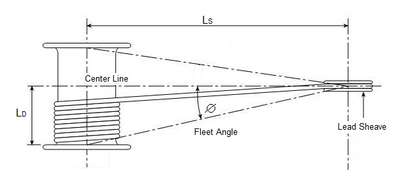
Contact Details:
Dymot Engineering Co. (Pty) Ltd.
11 Derrick Road
Spartan
Kempton Park
Gauteng
South Africa
Tel: +27 (0)11 970-1920
Fax: +27 (0)11 970-1979
Send Enquiry | Company Information

USEFULL INFORMATION FOR WINCHING APPLICATIONS – PART 2
Product News Monday, March 6, 2017: Dymot Engineering Co. (Pty) Ltd.
FLEETING ANGLE DRUM TO LEAD SHEAVE
The fleet angle Ø, as displayed in FIGURE 1, governs the position of the lead sheave with respect to the drum. When the rope is at one end of the drum, against the drum flange, this fleet angle may not exceed one and a half degrees (1.5°) for plain drums to two degrees (2°) for grooved drums left or right from the centre line passing through the centre of the sheave groove and the midpoint of the drum.
The midpoint of the drum is donated by distance LD in FIGURE 1.
Fleet angles larger than these suggested parameters can cause bad rope winding on drums and the rope can rub against the flanges of the sheave groove.
A safe rule of thumb that can be used is to multiply the length of the drum by 16. This will be equivalent to the distance LS that the lead sheave needs to be away from the winch. This distance will automatically result in a fleet angle of between 1.5 - 2°.
FLEETING ANGLE SHEAVE TO SHEAVE
It is recommended that sheaves operate centre line to centre line where possible.
The fleet angle Ø between two sheaves can be up to 2.5° left or right of the centre line passing through the centre of each sheave groove.
Dymot is involved with the majority of Mining Projects and have products in more than 40 countries.
For more information please contact us on 011 970 1920 or visit our website at www.dymot.co.za .
Jorick Snyman – Mechanical Engineer – Dymot Engineering Company
